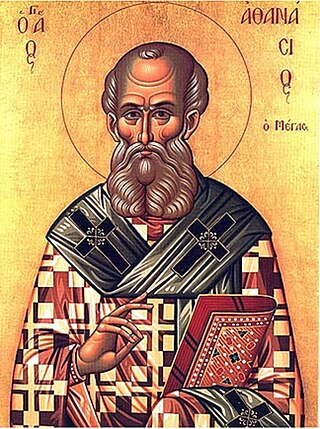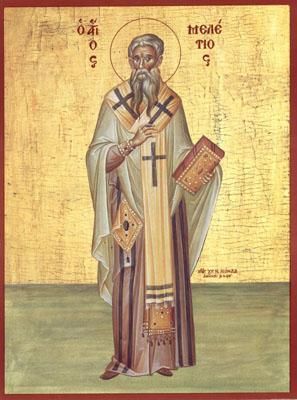Related Research Articles
Arianism is a Christological doctrine considered heretical by all mainstream branches of Christianity. It is first attributed to Arius, a Christian presbyter who preached and studied in Alexandria, Egypt. Arian theology holds that Jesus Christ is the Son of God, who was begotten by God the Father with the difference that the Son of God did not always exist but was begotten/made before time by God the Father; therefore, Jesus was not coeternal with God the Father, but nonetheless Jesus began to exist outside time as time applies only to the creations of God.

Athanasius I of Alexandria, also called Athanasius the Great, Athanasius the Confessor, or, among Coptic Christians, Athanasius the Apostolic, was a Christian theologian and the 20th patriarch of Alexandria. His intermittent episcopacy spanned 45 years, of which over 17 encompassed five exiles, when he was replaced on the order of four different Roman emperors. Athanasius was a Church Father, the chief defender of Trinitarianism against Arianism, and a noted Egyptian Christian leader of the fourth century.
The 360s decade ran from January 1, 360, to December 31, 369.
Pope Liberius was the bishop of Rome from 17 May 352 until his death. According to the Catalogus Liberianus, he was consecrated on 22 May as the successor to Julius I. He is not mentioned as a saint in the Roman Martyrology. That makes him the earliest pontiff not to be venerated as a saint in the Catholic Church and, along with Anastasius II, one of only two popes to be omitted from Catholic sainthood in the first 500 years of church history.

Hilary of Poitiers was Bishop of Poitiers and a Doctor of the Church. He was sometimes referred to as the "Hammer of the Arians" and the "Athanasius of the West". His name comes from the Latin word for happy or cheerful. In addition to his important work as bishop, Hilary was married and the father of Abra of Poitiers, a nun and saint who became known for her charity.

Saint Meletius was a Christian bishop of Antioch from 360 until his death in 381. However, his episcopate was dominated by a schism, usually called the Meletian schism.
Eudoxius was the eighth bishop of Constantinople from January 27, 360 to 370, previously bishop of Germanicia and of Antioch. Eudoxius was one of the most influential Arians.

Hosius of Corduba, also known as Osius or Ossius, was a bishop of Corduba and an important and prominent advocate for Homoousion Christianity in the Arian controversy that divided the early Christianity.
The Councils of Sirmium were the five episcopal councils held in Sirmium in 347, 351, 357, 358 and finally in 375 or 378. The third—the most important of the councils—marked a temporary compromise between Arianism and the Western bishops of the Christian church. At least two of the other councils also dealt primarily with the Arian controversy. All of these councils were held under the rule of Constantius II, who was sympathetic to the Arians.
Acacius of Caesarea was a Christian bishop probably originating from Syria; Acacius was the pupil and biographer of Eusebius and his successor on the see of Caesarea Palestina. Acacius is remembered chiefly for his bitter opposition to Cyril of Jerusalem and for the part he was afterwards enabled to play in the more acute stages of the Arian controversy. The Acacian theological movement is named after him. In the twenty-first oration of St. Gregory Nazianzen, the author speaks of Acacius as being "the tongue of the Arians".
Semi-Arianism was a position regarding the relationship between God the Father and the Son of God, adopted by some 4th-century Christians. Though the doctrine modified the teachings of Arianism, it still rejected the doctrine that Father, Son, and Holy Spirit are co-eternal, and of the same substance, or consubstantial, and was therefore considered to be heretical by many contemporary Christians.

Lucifer of Cagliari was a bishop of Cagliari in Sardinia known for his passionate opposition to Arianism. He is venerated as a Saint in Sardinia, though his status remains controversial.
The Council of Ariminum, also known as the Council of Rimini, was an early Christian church synod in Ariminum, modern-day Rimini, in 359. Called by Roman Emperor Constantius II to resolve the Arian controversy, the Council of Ariminum for western bishops paralleled the Council of Seleucia for eastern bishops.
Auxentius of Milan or of Cappadocia, was an Arian theologian and bishop of Milan. Because of his Arian faith, Auxentius is considered by the Catholic Church as an intruder and he is not included in the Catholic lists of the bishops of Milan such as that engraved in the Cathedral of Milan.
The Arian controversy was a series of Christian disputes about the nature of Christ that began with a dispute between Arius and Athanasius of Alexandria, two Christian theologians from Alexandria, Egypt. The most important of these controversies concerned the relationship between the substance of God the Father and the substance of His Son.
The Pneumatomachi, also known as Macedonians or Semi-Arians in Constantinople and the Tropici in Alexandria, were an anti-Nicene Creed sect which flourished in the regions adjacent to the Hellespont during the latter half of the fourth, and the beginning of the fifth centuries. They denied the godhood of the Holy Ghost, hence the Greek name Pneumatomachi or 'Combators against the Spirit'.

Saint Paulinus of Trier was bishop of Trier and a supporter of Athanasius in the conflict with Arianism. At the Synod of Arles (353) he was targeted by the Arians, and was exiled to Phrygia, being effectively singled out by the Emperor Constantius II. He died in exile five years later, but his remains were returned to Trier in 395. His tomb is in the crypt of the city's St. Paulinus' Church, which was rededicated to him.

Constantine the Great's (272–337) relationship with the four Bishops of Rome during his reign is an important component of the history of the Papacy, and more generally the history of the Catholic Church.
The Diocese of Scythopolis is a titular see in Israel/Jordan and was the Metropolitan of the Roman province of Palestina II. It was centered on Modern Beth Shean (Bêsân).
Arian creeds are the creeds of Arian Christians, developed mostly in the fourth century when Arianism was one of the main varieties of Christianity.
References
- ↑ Chisholm, Hugh, ed. (1911). "Hilarius, St" . Encyclopædia Britannica. 13 (11th ed.). Cambridge University Press. pp. 458–459.
- ↑ According to the tradition this council was thought to have taken place in the chapel of Saint-Clément, no longer extant, near the present church of Saint-Médard.
- ↑ On the Council of Paris and the texts that were adopted see Jean Gaudemet, Conciles gaulois du IVe siècle, Sources chrétiennes 241, Le Cerf, Paris, 1977